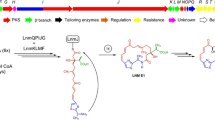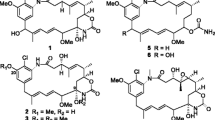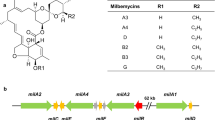Abstract
Constitutive overexpression of regulators in the ansamitocin biosynthetic cluster of Actinosynnema pretiosum was investigated as a strategy to increase the production of ansamitocin-P3 (AP-3), a clinically promising chemotherapeutic agent. Putative transcriptional regulators asm2, asm29, and asm34 as well as the putative regulatory protein asm39 were cloned into a single-site integrative vector and a multicopy replicative vector, pAP40 and pREP, respectively, and then transformed into A. pretiosum. Transformants overexpressing asm2 and asm39 in pREP showed an increase in ansamitocin production (1.3-fold over parental levels) in a bioassay screen. In shake-flask fermentations, the asm2 and asm39 overexpression transformants attained a maximum AP-3 titer of 33 and 52 mg/l, respectively, which were 1.6- and 2.5-fold higher than the blank vector control. The increase in AP-3 production for the asm2 overexpression transformant was unexpected, since prior reports suggested that Asm2 was a transcriptional repressor. The increase in production appeared to be dependent on the high expression levels achieved with the replicative vector, which may have disrupted the normal function of Asm2. Quantitative reverse-transcription polymerase chain reaction (RT-PCR) confirmed that asm2 and asm39 transcription levels were significantly higher in the transformants relative to the control, suggesting that the yield improvement was due to the transformed plasmids. This study demonstrates that deregulated overexpression of regulatory genes is a feasible strategy to increase AP-3 production in A. pretiosum.



Similar content being viewed by others
References
Bibb MJ (2005) Regulation of secondary metabolism in streptomycetes. Curr Opin Microbiol 8:1–8
Cassady JM, Chan KK, Floss HG, Leistner E (2004) Recent development in the maytansinoid antitumor agents. Chem Pharm Bull 52:1–26
Chater KF, Bibb MJ (1996) Regulation of bacterial antibiotic production. In: Kleinkauf H, von Döhren H (eds) Products of secondary metabolism, biotechnology, 7. Weinheim-VCH, New York, pp 57–105
Chung J and Byng GS (2003) Mutant Actinosynnema pretiosum strain with increased maytansinoid production. US Patent 0157694A1
Fernández-Moreno MA, Caballero JL, Hopwood DA, Malpartida F (1991) The act cluster contains regulatory and antibiotic export genes, direct targets for translational control by the bldA tRNA gene of Streptomyces. Cell 66:769–780
Fernández-Moreno MA, Martín-Triana AJ, Martínez E, Niemi J, Kieser HM, Hopwood DA, Malpartida F (1992) abaA, a new pleiotropic regulatory locus for antibiotic production in Streptomyces coelicolor. J Bacteriol 174:2958–2967
Goh S, Camattari A, Ng D, Song R, Madden K, Westpheling J, Wong VVT (2007) An integrative expression vector for Actinosynnema pretiosum. BMC Biotechnol 7:72
Higashide E, Asai M, Ootsu K, Tanida S, Kozai Y, Hasegawa T, Kishi T, Sugino Y, Yoneda M (1977) Ansamitocin, a group of novel maytansinoid antibiotics with antitumor properties from Nocardia. Nature 270:721–722
Huang J, Shi J, Molle V, Sohlberg B, Weaver D, Bibb MJ, Karoonuthaisiri N, Lih CJ, Kao CM, Buttner MJ, Cohen SN (2005) Cross-regulation among disparate antibiotic biosynthetic pathways of Streptomyces coelicolor. Mol Microbiol 58:1276–1287
Kieser T, Bibb MJ, Buttner MJ, Chater KF, Hopwood DA (2000) Practical Streptomyces genetics. The John Innes Foundation, Norwich
Kim ES, Song JY, Kim DW, Chater KF, Lee KJ (2008) A possible extended family of regulators of sigma factor activity in Streptomyces coelicolor. J Bacteriol 190:7559–7566
Kirschning A, Harmrolfs K, Knobloch T (2008) The chemistry and biology of the maytansinoid antitumor agents. C R Chimie 11:1523–1543
Liu C, Chari RV (1997) The development of antibody delivery systems to target cancer with highly potent maytansinoids. Expert Opin Investig Drugs 6:169–172
McKenzie NL, Nodwell JR (2007) Phosphorylated AbsA2 negatively regulates antibiotic production in Streptomyces coelicolor through interactions with pathway-specific regulatory gene promoters. J Bacteriol 189:5284–5292
Pfaffl MW (2001) A new mathematical model for relative quantification in real-time RT-PCR. Nucleic Acids Res 29:e45
Ramos JL, Martinez-Bueno M, Molina-Henares AJ, Teran W, Watanabe K, Zhang X, Gallegos MT, Brennan R, Tobes R (2005) The TetR family of transcriptional repressors. Microbiol Mol Biol Rev 69:326–356
Shuler ML, Kargi F (1992) Bioprocess engineering—basic concepts. Prentice-Hall, New Jersey
Srinivasulu B, Kim YJ, Chang Y-K, Shang G, Yu T-W, Floss HG (2006) Construction of asm2 deletion mutant of Actinosynnema pretiosum and medium optimization for ansamitocin P-3 production using statistical approach. J Microbiol Biotechnol 16:1338–1346
Takano E, Gramajo HC, Strauch E, Andres N, White J, Bibb MJ (1992) Transcriptional regulation of the redD transcriptional activator gene accounts for growth-phase-dependent production of the antibiotic undecylprodigiosin in Streptomyces coelicolor A3(2). Mol Microbiol 6:2797–2804
Tanida S, Hasegawa T, Hatano K, Higashide E, Yoneda M (1980) Ansamitocins, maytansinoid antitumor antibiotics producing organism, fermentation and antimicrobial activities. J Antibiot (Tokyo) 33:192–198
Yu T-W, Bai L, Clade D, Hoffmann D, Toelzer S, Trinh KQ, Xu J, Moss SJ, Leistenr E, Floss HG (2002) The biosynthetic gene cluster of the maytansinoid antitumor agent ansamitocin from Actinosynnema pretiosum. Proc Natl Acad Sci USA 99:7968–7973
Acknowledgments
We thank Sabrina Yeo for help with vector construction; Corrine Wan, Ong Boon Tee, and Lee May May for help with AP-3 quantification; Janet Westpheling for the E. coli ET12567 strain and pKS1 vector; Andrea Camattari and Dave Ow for useful discussions throughout the course of the work; and Niki Wong for critical review of the manuscript. The work was supported by the Biomedical Research Council of A*STAR (Agency for Science, Technology and Research), Singapore.
Author information
Authors and Affiliations
Corresponding author
Rights and permissions
About this article
Cite this article
Ng, D., Chin, H.K. & Wong, V.V.T. Constitutive overexpression of asm2 and asm39 increases AP-3 production in the actinomycete Actinosynnema pretiosum . J Ind Microbiol Biotechnol 36, 1345–1351 (2009). https://doi.org/10.1007/s10295-009-0619-7
Received:
Accepted:
Published:
Issue Date:
DOI: https://doi.org/10.1007/s10295-009-0619-7




